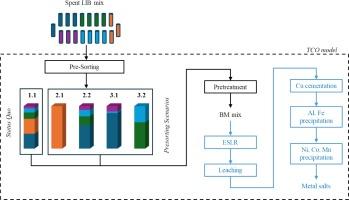废锂电池混渣湿法冶金回收的技术经济评价
IF 7.1
2区 环境科学与生态学
Q1 ENGINEERING, ENVIRONMENTAL
引用次数: 0
摘要
锂离子电池(lib)的日益多样化已经引入了一系列阴极活性材料(CAMs),目前至少有五种主要类型正在使用。就目前的回收实践而言,报废的锂电池通常在没有任何预分类的情况下进行处理,这导致混合CAM黑质量输入用于湿法冶金处理。本研究评估了混合CAM条件下标准湿法冶金工艺的性能,并通过使用总拥有成本(TCO)方法将其与两种假设的预测情景进行了比较。从技术上讲,磷酸铁锂(LFP)黑团的存在会导致杂质,对工艺效率产生负面影响。从经济上讲,与混合CAM基线相比,单独使用部分预分选来回收富钴馏分的总体价值较低,因为剩余材料的适销性降低。然而,进一步去除LFP和锂锰氧化物(LMO)可以提高工艺质量和经济效益,因为大多数黑色物质可以在没有主要污染物的情况下进行处理。结果还表明,所评估的湿法冶金工艺不适合LFP回收,因此强调需要针对磷酸盐基化学品制定特定的处理策略。本文章由计算机程序翻译,如有差异,请以英文原文为准。

A techno-economic evaluation of the hydrometallurgical recycling of mixed CAM black mass from spent LIB cells
The increasing diversity of lithium-ion batteries (LIBs) has introduced a range of cathode active materials (CAMs), with at least five major types currently in use. Regarding current recycling practices, end-of-life LIB cells are typically processed without any presorting, which results in a mixed CAM black mass input for hydrometallurgical treatment. This study evaluates the performance of a standard hydrometallurgical process under mixed CAM conditions and compares it with two hypothetical presorting scenarios by using a total cost of ownership (TCO) approach. Technically, the presence of lithium iron phosphate (LFP) black mass causes impurities that negatively affect process efficiency. Economically, the usage of partial presorting alone to recover cobalt-rich fractions results in a lower overall value compared to the mixed CAM baseline, due to the reduced marketability of the remaining material. However, further removal of LFP and lithium manganese oxide (LMO) improves both process quality and economic profitability, as most of the black mass can then be treated without major contaminants. The results also indicate that the hydrometallurgical process evaluated is not suitable for LFP recycling, thus highlighting the need for specific treatment strategies for phosphate-based chemistries.
求助全文
通过发布文献求助,成功后即可免费获取论文全文。
去求助
来源期刊

Waste management
环境科学-工程:环境
CiteScore
15.60
自引率
6.20%
发文量
492
审稿时长
39 days
期刊介绍:
Waste Management is devoted to the presentation and discussion of information on solid wastes,it covers the entire lifecycle of solid. wastes.
Scope:
Addresses solid wastes in both industrialized and economically developing countries
Covers various types of solid wastes, including:
Municipal (e.g., residential, institutional, commercial, light industrial)
Agricultural
Special (e.g., C and D, healthcare, household hazardous wastes, sewage sludge)
 求助内容:
求助内容: 应助结果提醒方式:
应助结果提醒方式:


